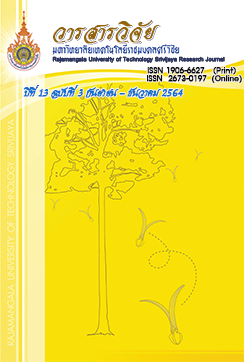Production of Fermented Vinegar from Cavendish Banana (Musa spp. AAA group)
Keywords:
vinegar, Cavendish banana, Saccharomyces cerevisiae, Acetobacter acetiAbstract
The present study aims at utilizing agricultural waste, which is overripe Cavendish bananas (Musa spp. AAA group), for fermented vinegar production. The three different ripe stages of Cavendish bananas including 1) over 100% ripe, 2) 100% ripe and 3) 30% ripe were prepared for vinegar production. For the ethanol fermentation (wines production), bananas were fermented by using Saccharomyces cerevisiae at 30 oC for 14 days. The results showed that there was no statistically significant difference in alcohol content among wine samples from three banana ripe stages which were in the range of 9.77 to 9.88 percent by volume. For the acetic acid fermentation (vinegar production), three banana wines were fermented by Acetobacter aceti TISTR 354 for 14 days. The results revealed that three vinegar samples had acetic acid content in the range of 6.63 to 7.19 percent by volume and the vinegar fermented from banana with 100% ripe stage had the highest acetic acid content (p ≤ 0.05). In addition, the analyses of total phenolic content, total flavonoid content and the antioxidant activities (ABTS and FRAP assay) of vinegar samples fermented from three different banana ripe stages were determined. The results showed that both phenolic and flavonoid compounds were still detected and had antioxidant potentials after alcohol and subsequent acetic acid fermentation steps.
References
Al Amri, F.S. and Hossain, M.A. 2018. Comparison of total phenols, flavonoids and antioxidant potential of local and imported ripe bananas. Egyptian Journal of Basic and Applied Sciences 5(4): 245-251.
AOAC. 2000. Official methods of analysis of AOAC inter¬national. 17th Edition. Association of official analytical chemists. Gaithersburg, MD. USA.
Aquino, C.F., Salomao, L.C.C., Ribeiro, S.M.R., Siqueira, D.L.D. and Cecon, P.R. 2016. Carbohydrates, Phenolic Compounds and Antioxidant Activity in Pulp and Peel of 15 Banana Cultivars. Revista Brasileira de Fruticultura 38(4): 1-11.
Chaikulsareewath, A. and Wongprayoon, P. 2006. Research and Development of Mango Wine. Journal of Food Technology Siam University 2(1): 28-35. (in Thai)
Chailangka, A. 2009. Development of vinegar drink from mulberry juice. CMU intellectual Repository. Available Source: http://cmuir.cmu.ac.th/handle/6653943832/20404, April 1, 2020. (in Thai)
Chanthima, N., Thaenthong, S. and Srisuworamas, B. 2015. Production and qualification analysis of vinegar from banana. Science and Technology Nakhon Sawan Rajabhat University Journal 7(7): 57-76. (in Thai)
Chumpookam, J., Subnum, V. and Jaruwattanaphan, T. 2014. Effect of component ratio on coffee pulp wine quality and consumer’s satisfaction. Khon Kaen Agricultural Journal 42(3): 415-420. (in Thai)
Davies, C.V., Gerard, L.M., Ferreyra, M.M., Schvab, M.D.C. and Solda, C.A. 2017. Bioactive compounds and antioxidant activity analysis during orange vinegar production. Food Science and Technology 37(3): 449-455.
Dudonne, S., Vitrac, X., Coutiere, P., Woillez, M. and Mérillon, J.M. 2009. Comparative study of antioxidant properties and total phenolic content of 30 plant extracts of industrial interest using DPPH, ABTS, FRAP, SOD, and ORAC assays. Journal of agricultural and food chemistry 57(5): 1768-1774.
Gokirmakli, Ç., Budak, N.H., Filiz, B.E. and Karakulak, I.D. 2019. Antioxidant Properties of Strawberry Vinegar. International Journal of Food Engineering 5(3): 171-174.
Iqbal, S., Bhanger, M.I. and Anwar, F. 2007. Antioxidant properties and components of bran extracts from selected wheat varieties commercially available in Pakistan. LWT-Food Science and technology 40(2): 361-367.
Jitjaroen, W. 2013. Wine Maker Handbook. 1st Edition. Chiangmai printing co.ltd, Chiangmai. (in Thai)
Konate, M., Akpa, E.E., Bernadette, G.G., Koffi, L.B., Ouattara, G., Honore, O.G. and Niamke, S.L. 2015. Banana Vinegars Production Using Thermotolerant Acetobacter pasteurianus Isolated from Ivorian Palm Wine. Journal of Food Research 4(2): 92-103.
Lapa, P., Chompreeda, P. and Haruthaithanasan, V. 2011. Development of Fermented Vinegar from Black Glutinous Brown Rice, pp. 793-800. In proceeding Khonkaen University National Graduate Research Conference 12th. Khonkaen University, Khonkaen. (in Thai)
Mangnoi, M., Srichayet, P. and Saithong, P. 2019. Production of vinegar and vinegar drink. Institute of Food Research and Product Development, Kasetsart University, Bangkok. (in Thai)
Prisacaru, A.E. and Oroian, M.A. 2018. Quality Evaluation of Vinegar Obtained from Banana Peel, pp. 259-264. In Proceedings, International Multidisciplinary Scientific GeoConference SGEM2018 18th. SGEM, Bulgaria.
Silayoi, B. 2002. Bananas. 3rded. Kasetsart University Press, Bangkok. (in Thai)
Sodchit, C. and Weeragul, K. 2012. Research Report no Increasing Potential of Banana Fragments in Phitsanulok Province: Production of Vinegar from Banana Fragments Prototype factory design and product marketing. Faculty of Agriculture, Natural Resource and Environment Naresuan University, Phitsanulok. (in Thai)
Srisa ad, A., Areesrisom, K. and Sumrongyen, P. 2018. Cavendish banana. 1st Edition. Naka intermedia co.ltd, Bangkok. (in Thai)
Su, M.S. and Chien, P.J. 2007. Antioxidant activity, anthocyanins, and phenolics of rabbiteye blueberry (Vaccinium ashei) fluid products as affected by fermentation. Food Chemistry 104(1):182-187.
Tanaka, C.A., Ruzon, F.I., Miranda, L.C.R., Galvan, D., Spinosa, W.A. and Castro-Goméz, R.J.H. 2016. Modeling and Kinetics of Bioconversion and Chemical Properties (Wine and Vinegar) from Banana Pulp By-Products. Preprints 2016. Available Source: https://www.preprints.org/manuscript/201612.0007/v1, April 1, 2020.
Downloads
Published
How to Cite
Issue
Section
License
The content and information in the article published in Journal of Rajamangala University of Technology Srivijaya It is the opinion and responsibility of the author of the article. The editorial journals do not need to agree. Or share any responsibility.







